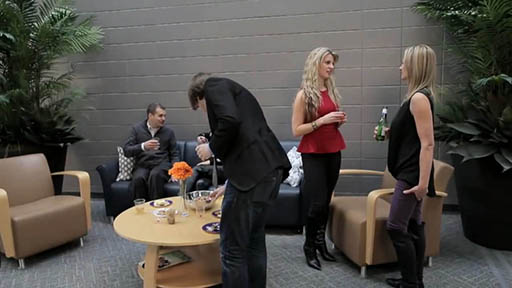4.1 Elevator pitch
An elevator pitch is so called because you must deliver it in the amount of time it might take to travel between floors in a lift or elevator. That means it needs to be brief and to the point, explaining who you are, what you have to offer and what you are looking for.
Watch this video from Canada’s York Region Government showing you some of the dos and dont’s of an elevator pitch.

Transcript: Video 6
[GRUNTS]
[SPEAKER 1 BUMPS INTO SPEAKER 2]
[TAKES SELFIE]
[READS OFF CARD]
This is a useful technique to get right as you never know when a quick summary of your situation will be useful.
Activity 6 My elevator pitch
In the box below, write five points that summarise what you want to cover in your elevator pitch. Remember the advice in the video about highlighting your accomplishments, your job history or your strengths. If you have a specific target or event in mind already, you could also tailor your points so that they are relevant to the individual or situation.
Now refine what you’ve listed so you can cover what you want to say in 20–30 seconds. Time yourself reading it out. If you’re feeling brave, record yourself on your phone and play it back.
Discussion
Did you manage to fit in everything you wanted to say? Did 30 seconds feel too long or not long enough? It doesn’t matter if you are a little over or under, the key is to make clear what you have to offer and what you want from them.
If you recorded your elevator pitch, perhaps you could show it to a trusted friend or colleague and ask for their feedback? Or better still, practise it in front of them.
It might be a bit much to ask the person you are speaking to for work experience in that first 30 seconds but it could be appropriate later in the conversation, particularly if they ask you what you do or what your future plans are.
Follow up
As the video mentioned, if you meet someone who you think will be a valuable connection, it is important to consolidate that connection by following up after the event. Make sure you end your conversation with a way to contact them – for example, ask for their business card or whether they are on LinkedIn.
Doyle (2019) offers the following tips:
- follow up within 24 hours so they are more likely to remember you
- mention a conversation from the event – also to jog their memory
- offer to help – it’s always a good idea to offer something before asking for a favour
- ask to meet up for a coffee – you might frame it as a chance to continue a conversation you were having at the event
- connect with them on LinkedIn to further strengthen your professional relationship
- edit, edit, edit – make sure your follow up communication doesn’t have any errors in it.
You’ll find out more about the nuances of networking with colleagues during your work experience, in Week 6.
